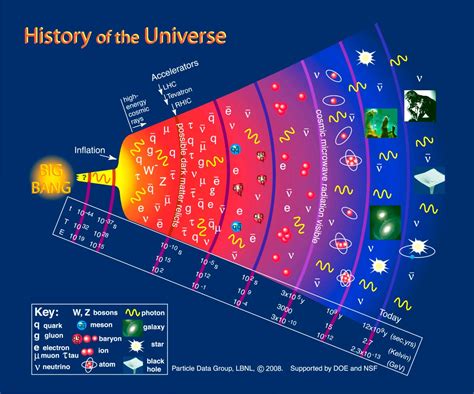Are you fascinated by the mysteries of the universe? Do you ever look up at the night sky and wonder about the secrets it holds? If so, you’ve come to the right place. In this blog post, we will delve into the captivating and mind-boggling world of astrophysics and cosmology. From the explosive birth of the universe in The Big Bang to the enigmatic forces of Dark Matter and Dark Energy, we will explore the most awe-inspiring phenomena that our universe has to offer. Join us as we unravel the secrets of Black Holes, understand the life cycles of stars, and learn about the electromagnetic spectrum. We will also discuss the echoes of the Big Bang found in Cosmic Microwave Background Radiation and the ongoing search for exoplanets beyond our solar system. Finally, we will touch on the recent discovery of Gravitational Waves and ponder the fate of the universe itself. So, buckle up and get ready for a cosmic journey unlike any other.
Table of Contents
The Big Bang: Birth of the Universe
The Big Bang theory is the prevailing cosmological model for the observable universe from the earliest known periods through its subsequent large-scale evolution.
According to this theory, the universe was in an extremely hot and dense state and began expanding rapidly about 13.8 billion years ago.
This rapid expansion caused the universe to cool and resulted in the existence of the current known subatomic forces, including gravity.
Over time, the universe continued to expand and cool, allowing the formation of simple atoms and eventually the stars and galaxies we see today.
The Expanding Universe: Hubble’s Law
The Expanding Universe is a fascinating and complex topic in the field of astronomy. It refers to the phenomenon in which the universe is constantly growing and spreading out, rather than remaining static. This concept was first proposed by Edwin Hubble, an American astronomer, in the early 20th century and is now widely accepted by the scientific community.
Hubble’s Law, named after Edwin Hubble, states that the speed at which a galaxy is moving away from us is directly proportional to its distance from the Earth. This means that the farther a galaxy is from us, the faster it is moving away. This concept provided the first observational evidence for the expansion of the universe and led to the development of the Big Bang Theory.
One of the key implications of Hubble’s Law is that it suggests the universe must have had a beginning at some point in the past. If the universe is expanding today, then it must have been much smaller and denser in the past. This supports the idea of the Big Bang, which proposes that the universe originated from a hot, dense state and has been expanding ever since.
This groundbreaking discovery has revolutionized our understanding of the cosmos and has opened up new doors for further research and exploration. Hubble’s Law has allowed astronomers to calculate the age of the universe, map the distribution of galaxies, and study the dynamics of cosmic expansion. It remains one of the most important and influential theories in the field of cosmology.
The Secrets of Dark Matter and Dark Energy
Dark matter and dark energy are two of the most enigmatic and mysterious substances in the universe, yet they make up the vast majority of its mass and energy. Dark matter is believed to be the invisible glue that holds galaxies together, while dark energy is driving the accelerated expansion of the universe.
Despite their profound impact on the cosmos, these two phenomena remain largely elusive and poorly understood. Scientists have been working tirelessly to uncover the secrets of dark matter and dark energy, using a combination of astrophysical observations, theoretical models, and cutting-edge technologies.
One of the most exciting aspects of the study of dark matter and dark energy is the potential to revolutionize our understanding of fundamental physics. Unraveling the mysteries of these elusive substances could lead to groundbreaking discoveries and a deeper insight into the nature of the universe.
As scientists continue to probe the depths of space and time in search of answers, the quest to unlock the secrets of dark matter and dark energy remains one of the most captivating and challenging endeavors in modern astrophysics.
Black Holes: The Cosmic Vacuum Cleaners
Black holes are truly fascinating and mysterious objects in the universe. These cosmic vacuum cleaners are formed from the remnants of massive stars that have gone through a supernova explosion. The gravitational pull in a black hole is so strong that nothing, not even light, can escape from it, making them invisible to the naked eye. They are like giant celestial vacuums, sucking in anything that gets too close to their event horizon, the point of no return.
Scientists have been studying black holes for decades, and while we have learned a lot about them, there is still much that remains unknown. The properties and behavior of black holes continue to puzzle researchers, leading to ongoing investigations and new discoveries.
One of the most intriguing aspects of black holes is their connection to the nature of space and time. According to Einstein’s theory of general relativity, the intense gravitational field around a black hole warps the fabric of space-time, causing it to curve inwards. This has profound implications for our understanding of the universe and the laws of physics.
As we delve deeper into the study of black holes, we may uncover more about the true nature of these enigmatic phenomena and their role in shaping the cosmic landscape. The ongoing research and observations of black holes will undoubtedly continue to captivate the minds of scientists and enthusiasts alike.
The Life Cycles of Stars: Birth, Life, and Death
Stars are born from vast clouds of dust and gas in space, called nebulae. These regions are dense with material, and as gravity pulls the particles together, they begin to heat up and form a protostar.
As the protostar continues to gather mass, it eventually reaches a point where nuclear fusion reactions begin in its core, marking the moment of its birth as a true, shining star. The star will then spend the majority of its life in the main sequence phase, where it steadily burns its fuel and emits energy.
Eventually, the star will run out of fuel and the balance of forces that keep it stable will be disrupted. This could cause the star to expand into a red giant, or if it is a larger star, it may undergo a supernova explosion. After this dramatic event, the remnants of the star may form a neutron star or a black hole, marking the end of its life cycle.
Understanding the life cycles of stars not only sheds light on the incredible processes that shape the universe, but also provides insight into the creation of elements essential for life, such as carbon and oxygen.
Understanding the Electromagnetic Spectrum
The electromagnetic spectrum is a fascinating and essential concept in the field of physics and astronomy. It refers to the range of all types of electromagnetic radiation, from high-frequency gamma rays to low-frequency radio waves. This spectrum encompasses a vast range of wavelengths and frequencies, each of which has unique properties and behaviors.
One key aspect of the electromagnetic spectrum is that each type of radiation interacts with matter in different ways. For example, gamma rays are highly energetic and can penetrate most materials, while radio waves are much less energetic and easily absorbed by obstacles such as buildings or walls. This diversity in how electromagnetic radiation interacts with the world around us has led to a wide range of practical applications in fields such as medicine, communication, and astronomy.
Understanding the electromagnetic spectrum is crucial for astronomers and astrophysicists, as it allows them to study the universe in different ways. By observing celestial objects across different wavelengths, scientists can gain a more comprehensive understanding of the cosmos. For example, visible light observations provide essential information about the composition and temperature of stars, while radio observations can reveal the presence of hydrogen gas clouds in distant galaxies.
Furthermore, the study of the electromagnetic spectrum has led to groundbreaking discoveries in astrophysics, such as the detection of pulsars, black holes, and cosmic microwave background radiation. It has also enabled astronomers to peer deep into the universe’s history and to study phenomena such as supernovae, quasars, and the early stages of the Big Bang.
Cosmic Microwave Background Radiation: Echoes of the Big Bang
The cosmic microwave background radiation is one of the most significant pieces of evidence supporting the Big Bang theory. It is the residual heat and light left over from the Big Bang, which occurred approximately 13.8 billion years ago. This radiation fills the entire universe and provides crucial insights into the early stages of cosmic evolution.
According to the Big Bang theory, the universe began as a hot and dense state, which rapidly expanded. As it expanded, the intense heat and energy began to cool and spread out, eventually leaving behind a faint radiation that permeates the cosmos. This radiation was first discovered in 1965 by Arno Penzias and Robert Wilson, who were awarded the Nobel Prize in Physics for their groundbreaking work.
The discovery of the cosmic microwave background radiation provided astronomers and cosmologists with a wealth of information about the universe’s early history. By studying the faint variations in this radiation, scientists have been able to map the distribution of matter in the early universe, confirming key aspects of the Big Bang theory and providing insights into the formation of galaxies and large-scale structures.
With advancements in technology and observational techniques, scientists continue to study the cosmic microwave background radiation to unravel the mysteries of the Big Bang and gain a deeper understanding of the origins and evolution of the universe.
The Search for Exoplanets: Worlds Beyond our Solar System
Exoplanets, also known as extrasolar planets, are planets that orbit stars outside of our solar system. The search for exoplanets has been a hot topic in astronomy in recent years, as scientists try to answer the age-old question: are we alone in the universe? This quest has led to some incredible discoveries and has expanded our understanding of the cosmos.
One of the most common methods for detecting exoplanets is the transit method, where astronomers look for small dips in a star’s brightness as a planet passes in front of it. This method has allowed scientists to identify thousands of exoplanets, some of which are in the habitable zone, where conditions might be right for life to exist.
Another method for finding exoplanets is by studying the radial velocity of stars. When a star wobbles back and forth, it can indicate the presence of an exoplanet orbiting around it, tugging on it with its gravitational pull. This method has also been successful in finding many exoplanets.
The search for exoplanets continues to be an exciting and rapidly evolving field of study, with new discoveries being made regularly. With the development of new technologies and space telescopes, we can look forward to even more exciting findings in the future.
Gravitational Waves: Ripples in Spacetime
Gravitational waves, as predicted by Albert Einstein’s general theory of relativity, are ripples in the fabric of spacetime. These waves are caused by the acceleration of massive objects, such as two black holes orbiting each other or neutron stars colliding. When these cataclysmic events occur, they send out ripples in spacetime that travel at the speed of light.
Gravitational waves were first detected by the Laser Interferometer Gravitational-Wave Observatory (LIGO) in 2015, confirming a major prediction of Einstein’s theory. This monumental discovery opened a new window for studying the universe, as gravitational waves provide a unique way of observing celestial events that are otherwise invisible.
One of the most significant aspects of gravitational waves is their potential to reveal information about events that cannot be observed using traditional telescopes. For example, the collision of two neutron stars, which was detected through gravitational waves, provided scientists with invaluable data about the formation of heavy elements like gold and platinum.
In addition to their scientific importance, gravitational waves also have practical applications. They can be used to study the properties of black holes and other exotic objects in the universe, as well as to test the limits of our understanding of gravity. As technology advances, gravitational wave astronomy promises to unlock a wealth of knowledge about the cosmos and revolutionize our understanding of the universe.
The Fate of the Universe: Expansion or Contraction?
The fate of the universe has been a topic of debate among scientists for many years. One of the key questions that researchers seek to answer is whether the universe will continue to expand indefinitely or whether it will eventually contract. This question has significant implications for our understanding of the ultimate destiny of the cosmos.
Scientists have long known that the universe is expanding, as demonstrated by the observation that galaxies are moving away from each other. This discovery, based on the work of astronomer Edwin Hubble, led to the development of Hubble’s Law, which describes the relationship between the distance of galaxies and their redshift. However, what remains uncertain is whether this expansion will continue at its current rate or whether it will eventually slow down and reverse.
One factor that could determine the fate of the universe is the amount of matter it contains. The force of gravity, which acts to pull matter together, could eventually overcome the expansion of the universe and lead to a contraction. Alternatively, if the amount of dark energy in the universe is sufficient, it could cause the expansion to accelerate, ultimately leading to a big freeze scenario where the universe continues to expand at an increasing rate.
At present, scientists are still gathering data and refining their models in an attempt to resolve this question. While it remains one of the great mysteries of cosmology, ongoing research and observations are bringing us closer to understanding the ultimate fate of the universe.





